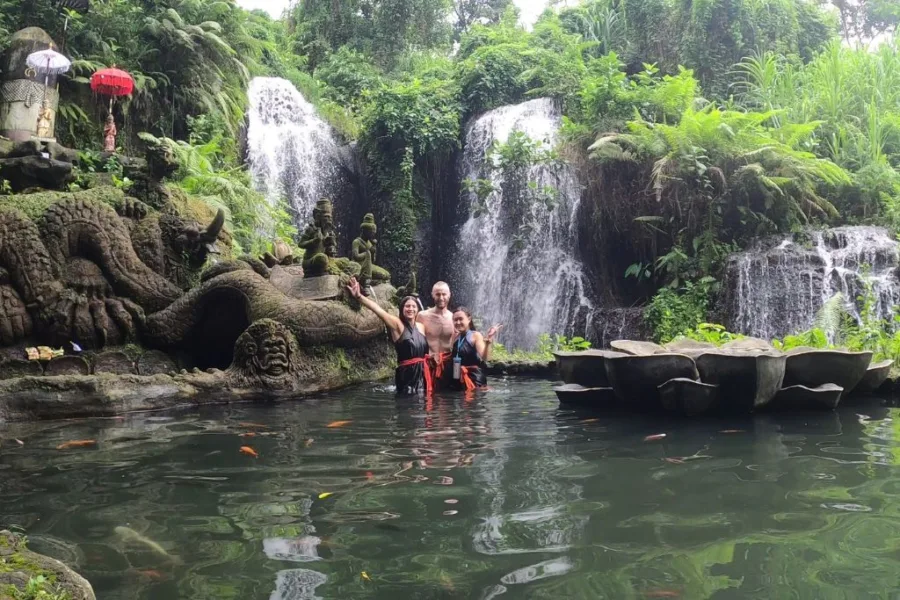During our stay in Bali, I desperately wanted to experience a Balinese Purification Ceremony. I had heard impressive things about the spiritual cleansing ceremony, and so after some research, we decided to go to Taman Beji Griya Waterfall.
We had heard that it was a sacred site amidst a waterfall and open to the public for rituals and spiritual cleansing, perfect!
A few days later, and in the early hours of the morning, we jumped on our scooters and headed for the waterfall. Surrounded by rice fields and lush jungles, the experience was much more immersive than we had anticipated.
The waterfall was stunning – we were visiting during the rainy season – and since it was a quieter period, we had the whole place to ourselves!

This post contains affiliate links. I will earn a small commission if you purchase through them, at no extra cost to you.
In this post, I’m going to run through our purification ceremony at Taman Beji Griya Waterfall so you know what to expect. I’m also going to cover topics including:
- Why we think Taman Beji Griya Waterfall is worth visiting.
- The sacred history of the waterfall.
- The benefits of the purification ceremony.
Are you planning a trip soon? Use my links below to book!
Accommodations – I recommend Booking.com
Flights – I recommend Skyscanner
Travel Insurance – I recommend SafetyWing
Tours/experiences – I recommend Get Your Guide
Car rental – I recommend DiscoverCars
These are all the sites I personally use to book my trips, and if you use them, some of them will earn me a commission at no extra cost to you. This helps reduce the ever-increasing costs of keeping my site up. Thanks!
Is Taman Beji Griya Waterfall Worth Visiting?
Taman Beji Griya Waterfall was a fantastic way for us to immerse ourselves in the Balinese culture of spiritual cleansing. We weren’t sure what to expect when we arrived but once we got there we were warmly greeted by the staff who provided everything we needed.

In truth, and at first, we were a little dubious as it sounded like a tourist trap. That didn’t change too much when we entered; cafe, restaurant, massage & healing rooms…there were a lot of ‘tourist’ facilities.

Nevertheless, we were there for a spiritual cleanse and so we continued on. The friendliness of the staff and the tranquil ambience soon diminished our hesitance and before long we began our spiritual cleansing journey.
It was a great and truly memorable experience. I’ll go into more detail below but we honestly enjoyed the experience. I think Taman Bei Griya Waterfall is worth visiting for the purification ceremony.

Since we went independently, it cost us 200,000 IDR p/p. There are day trips available which will arrange transport and guides. In hindsight, it would have been nice to of had a guide who could have explained in depth the ritual process and religious aspects/deities of the ceremony.

Taman Beji Griya Waterfall Review: Overall, it was a wonderful and positive experience. The only thing I would note is since we went during a quiet period I can’t vouch for the crowds. I would recommend visiting Bali during the shoulder months to avoid crowds. That said, Taman Beji Griya waterfall isn’t as busy as other sites.

🏆 BEST OVERALL TOUR
EDITOR’S PICK. Best PURIFICATION CEREMONY at Beji Griya Waterfall: Natural Holy Waterfalls Healing Tour
✔️Purification Ceremony
✔️Uma Pakel Agro
✔️Tegalalang Rice Terrace
About Taman Beji Griya Waterfall
Before we dive into the Balinese purification ceremony, I wanted to talk a little about Taman Beji Griya Waterfall and its history.

The waterfall is a captivating natural wonder nestled within the landscapes of rural Bali and stands as the crowning jewel. The thought that I would soon be standing underneath it washing away my impurities was stimulating!

It stands as a testament to the profound connection between history, spirituality, and the enduring embrace of sacred whispers. It reminds us that within the gentle cascade of water, the echoes of the past guide us toward a future of harmony.
The whole site is enthralled by a serene and spiritual ambience, encircled by lush rice fields and untamed wilderness on the edges of Punggul village. I found its idyllic location made it even more captivating.

The waterfall itself tumbles gracefully down a series of rocky steps, creating a picturesque scene. The site offers relaxation and meditation spaces alongside the rituals.
It is possible to visit and immerse yourself in the surroundings, although you will still have to pay an entrance fee of 100,000 IDR. That said, the reason to visit Taman Beji Griya Waterfall is to partake in the purification ceremony.

Taman Beji Griya Waterfall’s History
As a profound spiritual site, this natural wonder was once the sanctuary of an ancestor of the Griya Gede Manuaba Punggul family. It carries a legacy deeply intertwined with the Balinese way of life. For generations, the cascading waterfalls and holy springs have been an integral part of religious ceremonies.

In 2018, a transformative moment unfolded as the landowners immersed themselves in meditation only to hear a voice devoid of a discernible source, yet carrying profound instructions.
This ethereal whisper beckoned them to repair, nurture, and safeguard the entirety of Beji Griya Waterfall’s sacred domain and to open this sacred sanctuary to the public.

Today, it welcomes visitors from around the world who are captivated by its beauty and the sense of serenity it offers. Visitors are invited to partake in the age-old tradition of purification – “Melukat” – a ritualistic bath that cleanses not only the body but also the soul.
Purification Ceremony Bali – Melukat
The Balinese purification ceremony known as “Melukat” holds a significant place in the island of God’s spiritual and cultural fabric. Melukat involves a series of ritualistic practices aimed at purifying the body, mind, and soul.

Typically, participants will gather at sacred water sources, such as waterfalls, rivers or temple pools. There they engage in prayers, offerings, and bathing rituals under the guidance of a priest.
Melukat is believed to cleanse individuals from negative energies, impurities, and spiritual blockages. It’s a transformative experience that not only rejuvenates the body but also renews your spiritual connection.

Benefits Of Purification Ceremony
The benefits of a Balinese purification ceremony are numerous but the main ones are physical, mental and spiritual healing.
Physically, the ceremony involves a ritual bath in holy water. Holy water is believed to possess purifying properties that cleanse the body of impurities and ailments, promoting physical wellness.

Mentally, the process of immersion is meditative, fostering mental clarity and emotional balance. The serene environment and meditative practices can lead to inner peace.
Spiritually, Melukat deepens your connection to your beliefs and traditions, fostering a sense of belonging and cultural identity.

Cultural Immersion
Culturally, participating in a Melukat ceremony offers a deep connection to Balinese heritage. Engaging in traditions passed down through generations fosters a sense of belonging and understanding of local culture.
In a world often dominated by fast-paced lives, a Melukat ceremony offers a serene pause, an opportunity for reflection, and a chance to embrace the rich spiritual heritage of Bali.

It’s a holistic journey that not only detoxifies the body but also uplifts the spirit, leaving you with a profound sense of renewal.
Where Is Taman Beji Griya Waterfall
Located in the village Punggul, near Ubud, Taman Beji Griya Waterfall offers a refreshing escape from bustling urban life.
Overview: Purification Ceremony At Taman Beji Waterfall
Once we had arrived and arranged for the purification ceremony we were asked to change into a sarong and each given a basket full of offerings. These offerings consisted of bamboo baskets filled with coconut, flowers, incense and biscuit cakes.

To begin with, we were taken to an open area full of shrines where we were asked to lay down a handful of offerings.
You’re to remove your shoes here and make your way down the rocky path to the base of the waterfall. The water fell between the rocks into small pools which flowed through crevices and along the trail. It was beautiful.

The rocks had a variety of detailed carvings in the shape of animals, or perhaps gods and were covered in moss and lichen. The sound of the cascading water was powerful and echoed into the fissure cave we were about to enter.

Before entering, we were gestured to place a few offerings at the foot of another stone shrine before continuing along the path further into the cave. Unfortunately, there was no description as to which deity the offerings were left for but we placed them regardless.

It was a surprise as we hadn’t expected to enter such a cave. It was covered in vines hanging down in front of our heads, and vegetation growing along the rock walls.; it was a wet, damp space but surreal and ethereal.

Stage 1: Penglukatan Tamba Sunia (Tamba Sunia Purification)
“Holy water to cure all diseases, a blessing for offspring, make it easier for a life partner and ask for harmony in the family.”
Upon entering the cave, we were directed through a narrow opening to the “hidden canyon shower”, nestled within the fissure cave. I laid down my final offering to stand under the falling water before heading to a holy spring to drink and make a prayer.

The secluded nature of this experience encouraged a personal connection with the environment and a detachment from the outer world. I found the sound of gently flowing water and the secluded setting set the tone for reflection.

The shower represents a symbolic cleanse to prepare for the deeper stages of purification ahead. I’m pretty sure there is meant to be a particular ritual cleanse performed here, but as tourists, it was a quick dip in and out – it was extremely cold!
Stage 2: Bulakan Rambut Sedana (Rambut Sedana Spring water)
“Holy water to find our fortune in life, and smooth flow in business, trade, career and everything related to money.”
Moving forward, we proceeded to the holy springs. These natural springs are believed to possess sacred and cleansing properties.

We were gestured to sit down before a blessing was performed, this time by pouring holy water over our heads. The “immersion” in the spring water is believed to physically and spiritually wash away impurities.
I will say that the sensation of the cool water falling over my head brought a sensation of rejuvenation. Maybe it could be said a renewal of sorts, akin to shedding old layers and embracing a fresh beginning.

Stage 3: Dewi Gangga’s Twin Waterfall
“The first waterfall is a place to release negative energy, emotions, burdens of thoughts, anger, revenge that is in the heart and mind by shouting or crying as much as you can. The second waterfall attracts and generates positive energy by expressing happiness by laughing, having fun, dancing or singing to your heart’s content.”
The centrepiece of this spiritual journey is the immersion under the breathtaking waterfall. After we had all had a turn being renewed we made our way along the rocks to stand under Taman Beji Griya Waterfall, otherwise known as Dewi Gangga Twin Waterfall.

We carried out our screaming, bellowing at the top of our lungs to release pent-up emotions and stresses allowing the waterfall to carry away these burdens. The thundering sound of the waterfall acts as a natural barrier, providing a sense of privacy to express and let go.

Afterwards, we moved along to the next section of the falls and began a kind of fake laughing until we were laughing in real life, I love how laughter is contagious! It was at this moment that I felt an intense rush of emotions which flooded over me and then disappeared as quickly as they had come.
It was unworldly, to say the least, and totally invigorating!
Stage 4: The Worship Of Ratu Niang Sakti & Ida Betara Lingsir
“Holy water to ask for grace: a blessing to always be given health, fortune, eternal happiness and all goodness”.
After we had finished laughing we had to climb up out of the waterfall along some carved out steps before we could enter the serene pool. I will note that it can be a little slippery and so care is needed.

The bathing ritual in the serene pool, alongside the koi, signifies a further refinement of the purification process.
Think of it kind of like a setting of the cleansing ceremony, where both the physical and spiritual elements are invoked by a sense of tranquillity, amplifying the purification experience.

Stage 5: Coconut Purification By The Priest
The last stage of the Bali purification ceremony is to be cleansed in the waters of young and yellow coconuts. This is done with the guidance of a priest who splashes the water over your head before you drink and then spread the water across your face.

This ritual is done in three’s and performed at each holy spring. It’s a case of pouring holy water over the head, drinking the water and then washing your face with it.

In Balinese culture, coconut water is a symbol of purity and renewal making it the perfect source to end the ceremony. The priest’s presence adds a spiritual dimension, infusing the ceremony with blessings and intention.

Afterwards, it’s one final prayer, some rice dashed across the forehead, a flower above the ear and a white, back and red cotton thread bracelet. The bracelet is the final step of the purification ceremony and is traditionally worn by Hindus for protection.
Overall, it was a captivating experience which we enjoyed.

FAQs: Taman Beji Griya Waterfall
What Is The Spiritual Meaning Of The Beji Griya Waterfall?
The Beji Griya Waterfall holds profound spiritual significance, symbolising a connection to the divine forces of nature. Its cascading waters represent a conduit between the physical and spiritual realms, offering a channel for purification and renewal. This natural wonder embodies the Balinese belief in harmony, cleansing, and the transformative power of water, making it a sacred space for seekers of spiritual enlightenment.
Taman Beji Griya Waterfall Opening Times
Monday: 9 am–6 pm
Tuesday: 9 am–6 pm
Wednesday: 9 am–6 pm
Thursday: 9 am–6 pm
Friday: 9 am–6 pm
Saturday: 9 am–6 pm
Sunday: 9 am–6 pm
Taman Beji Griya Waterfall Entrance Fee
The cost is 100.000 IDR/ Credit cards accepted to enter and a further 100,000 IDR for the purification ceremony. Keep in mind, with this cost you won’t get an English-speaking guide only someone to direct you around the sacred site.

“Om Shanti Shanti Shanti Om”
You might hear this expression being sung during your spiritual journey, or even throughout Bali.
“Om Shanti Shanti Shanti Om” is a mantra often chanted in Hinduism and some other spiritual practices. The mantra consists of three repetitions of the word “Shanti,” which translates to “peace” in Sanskrit. Here’s the breakdown of the mantra:
- Om: “Om” is a sacred sound and a spiritual symbol in Hinduism, Buddhism, and other Indian religions. It represents the ultimate reality, consciousness, and the sound of creation.
- Shanti: “Shanti” is the Sanskrit word for “peace.” Chanting it three times emphasises the desire for peace in three realms: physical, mental, and spiritual.
So, “Om Shanti Shanti Shanti Om” can be understood as a prayer or invocation for peace on all levels. Within oneself, in the world around, and in the greater cosmic context.
The repetition of “Shanti” is a way of amplifying the intention for peace and tranquillity. It’s often chanted during meditation, prayer, or as part of a ritual to cultivate a sense of inner harmony and to extend positive energy to the world.

Resources For Bali
Is it your first time visiting Bali? We’ve written lots of useful posts to help you plan your trip. You can check them all out on our Bali Page here, but below are some of our most popular articles:
- Want to know where our favourite waterfall in Bali was? Read this post on Aling Aling!
- The best way to get around the Island of Gods is by Scooter, but you’ll need to make sure you have a few essential items.
- Another few activities you might enjoy in Bali include Campughan Ridge, Kajeng Rice Fields, and hiking to the summit of Mount Batur.
Taman Beji Griya Waterfall: Purification Ceremony Bali
From our experience, Taman Beji Griya Waterfall and Purification Ceremony were truly a rejuvenating adventure. We enjoyed ourselves thoroughly and recommend you to visit too.
Having moved beyond its history as a private ancestral site, Beji Griya Waterfall has been transformed with tourists in focus. This development might have diluted some of its authenticity compared to smaller sites.
Nevertheless, the ritual stages and, most importantly, the profound purification experience beneath the waterfall have earned a big thumbs up from us.

Explore & Discover More
Come and join our socials and keep up to date with the latest adventures. Find the latest travel photos, and blog updates, ask questions and get travel inspiration.
✔️ FIND ON INSTAGRAM
✔️ JOIN US ON FACEBOOK










